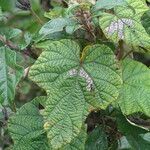A very variable perennial; stems twining or prostrate, up to 4 m. long, covered with ± spreading yellowish hairs.. Leaf-blade ovate-cordate, up to 10(–13) cm. long and 7(–12) cm. wide in outline, either entire or shallowly to deeply 3-lobed, with lobes acute and margins entire or crenate, green but pilose above, with dense to very sparse white-cottony tomentum beneath; petiole up to 9.5 cm. long.. Flowers in few-to many-flowered, dense to somewhat lax heads, very rarely solitary; peduncle 7–29 cm. long.. Sepals linear to ovate-lanceolate, 6–16 mm. long, 2.5–5 mm. wide, obtuse or acuminate, with 3 kinds of indumentum, white-cottony tomentum, adpressed or spreading yellow bristles and sessile or stalked marginal glands; one or more of these kinds may be absent.. Corolla magenta or mauve, 2–3(–5) cm. long, glabrous or ± yellow-bristly above.. Capsule globose, 6–7 mm. in diameter, slightly to densely bristly above or with faint white tomentum.. Seeds ovoid, 4 mm. long, black with scattered lines of short and long white hairs.
Variable herbaceous perennial. Stems twining or prostrate, yellow-or brown-hairy, up to 3 m long. Leaves 30-130 mm long, entire to 3-lobed, basal lobes rounded, sinus deep and narrow; green and strigose above, densely cobwebby below with conspicuous veins, margins entire to repand; petioles pilose, up to 90 mm long. Inflorescence a dense cyme; peduncle hairy, 30-130 mm long; bracteoles lanceolate, hirsute, 10-12 mm long; pedicels absent. Sepals equal, linear-lanceolate, 8-15 mm long, indumentum of 3 kinds: white-cottony tomentum, yellow bristles, marginal glands. Corolla funnel-shaped, mauve to purple, 20-40 mm long; midpetaline areas well-defined, glabrous. Flowering time all year, mostly Jan.-May. Fruit a subglobose capsule, bristly or white-tomentose, 8-10 mm long. Seeds ovoid, dark brown, 3 mm long, shortly pubescent or glabrous.
Perennial climber or twining or prostrate herb. Leaves ovate-cordate, entire or shallowly to deeply 3-lobed; lobes acute and margins entire or crenate; covered with floccose-arachnoid tomentum below, appearing white. Flowers in few-to many-flowered, dense to somewhat lax, pedunculate heads. Sepals linear to ovate-lanceolate, obtuse or acuminate, with 3 kinds of indumentum: white-cottony, appressed or spreading yellow bristles and sessile or stalked marginal glands (1 or more sometimes absent). Corolla 20-35 mm long. Flowers magenta or mauve.






